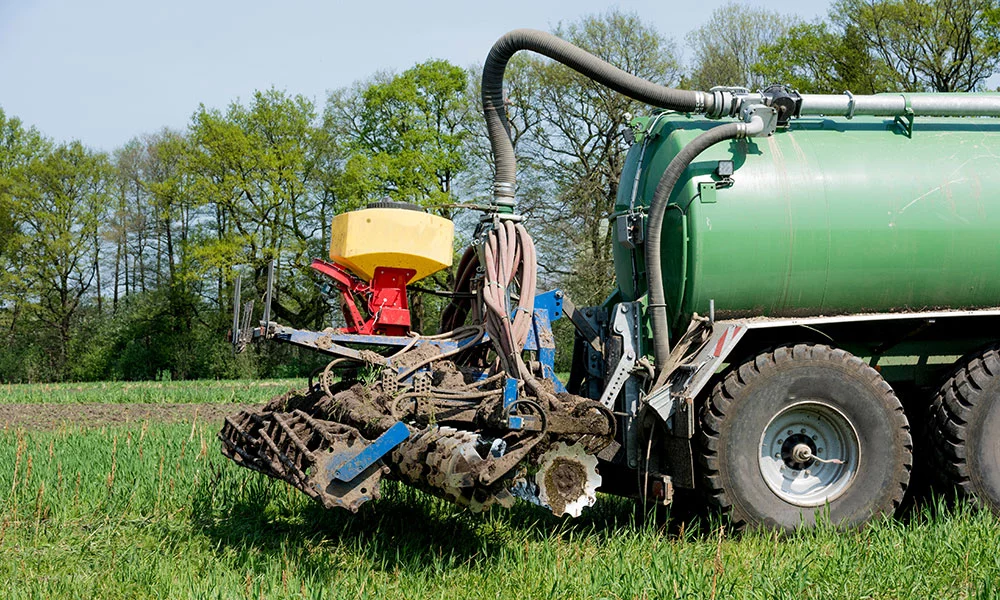Spreading for Success: When is the best time to conduct digestate spreading?

As the popularity of digestate has grown, so too has the number of farmers choosing to implement their own digestate solutions. Many farms are now favouring digestate spreading over traditional spreading methods, like slurry or artificial fertilisers.
According to Farmers Weekly, using anaerobic digestate to feed arable crops can save farmers up to £110/ha on bagged fertiliser costs. When used correctly, the product can help restore soil health, repair local ecosystems, enhance worm activity and allow farmers to gain more grazing days.
While the benefits of utilising a digestate solution are regularly lauded, you should also be mindful of the number of restrictions surrounding the application of the product. Not only can incorrect use have an adverse effect on your land, but it could also get you in serious trouble with the law.
Optimum digestate spreading times
In its liquid state, digestate is a volatile substance, and its quality can easily be impaired. If the product isn’t stored correctly, or spreading doesn’t take place during optimum times, then it can become susceptible to ammonia volatilisation into the atmosphere, or nitrate leaching into nearby water sources.
The application of digestate spreading is carried out in line with the current Cross Compliance Guidelines, but generally takes place from late winter through to the end of summer. Application of the product should be avoided during the autumn months, as nitrogen will not typically be absorbed effectively by arable crops during this time.
Current NVZ closed period dates
To make sure that your digestate spreading complies with the current Cross Compliance Guide, the NFU has put together a handy guide to help. During these times, livestock slurries, digestate products and poultry manures cannot be applied to land.
Closed period for livestock slurries, digestate and poultry manures
The current closed period for applying organic manure with high readily available nitrogen content (including liquid anaerobic digestate) are as follows:
Start Date |
End Date |
Land Use |
Soil Type |
| 1 August | 31 December | Tillage land | Shallow or sandy soils |
| 1 September | 31 December | Grassland | Shallow or sandy soils |
| 16 September | 31 December | Tillage land with crops sown on or before 15 September | Shallow or sandy soils |
| 1 October | 31 January | Tillage land | All other soils |
| 15 October | 31 January | Grassland | All other soils |
Always check the weather forecast
When it comes to digestate spreading, careful planning is crucial. In order to minimise losses and reduce the odour of the product, digestate should be applied during good growing conditions, using a band applicator or shallow injection system.
Persistent bad weather can make applying digestate difficult, due to the increased risk of run-off and the subsequent pollution that this could cause to nearby water sources and wildlife. Avoiding digestate spreading is also advised during the following scenarios:
• The land is waterlogged, covered in snow or frozen
• Heavy rainfall is forecast within 48 hours (or it is already raining heavily)
• During periods of heavy snow
• The soil has cracked down to the field drains
• A field has been pipe or mole drained
• A field has been sub-soiled over drains within the past twelve months
Similarly, digestate solutions are not suitable for every farm. It is the responsibility of you, the farmer or landowner, to ensure that adequate checks have been undertaken to assess the quality of your land, and make sure that digestate spreading doesn’t take place in the following circumstances:
• Where the land is located within 10 metres of a ditch, pond or water surface
• Where the land is located within 50 metres of a water supply used by human or dairy farms (including springs, boreholes or reservoirs)
• Where the land is situated on a steep slope.
Failing to comply with these rules could land your business in serious legal trouble – polluting water sources during spreading could incur a fine of up to £20,000.
Utilising AWSM Farming’s digestate spreading services
Here at AWSM Farming, we specialise in digestate spreading. We offer our customers a highly effective, professionally-completed fertilisation system that is tailored to best suit the needs of your land, while being economically-friendly.
Working with our teams of agricultural contractors, we can construct suitable digestate storage in as little as 48 hours. Choosing to utilise local digestate storage can increase the ease of use of the product on your land, while minimising the likelihood of missing vital spreading days because the product isn’t readily available.
The bottom-line
In recent years, digestate spreading has become a popular choice for farmers seeking a cheap-yet-effective alternative to slurry spreading.
Ultimately, it is always worth keeping in mind that digestate is a fantastic product, but it is regulated for a good reason. Before committing to utilising it on your land, make sure that you have carried out the necessary checks that ensure that your land is suitable, and that spreading is undertaken in-line with the current Cross Compliance Guidelines.





